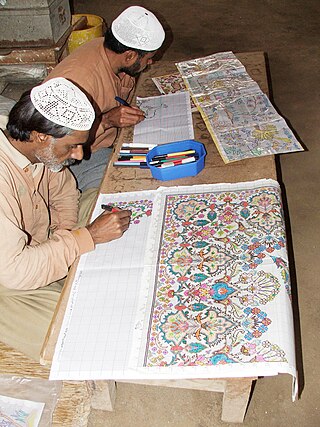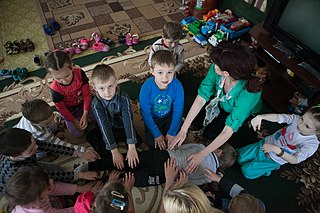
Psychotherapy is the use of psychological methods, particularly when based on regular personal interaction, to help a person change behavior, increase happiness, and overcome problems. Psychotherapy aims to improve an individual's well-being and mental health, to resolve or mitigate troublesome behaviors, beliefs, compulsions, thoughts, or emotions, and to improve relationships and social skills. Numerous types of psychotherapy have been designed either for individual adults, families, or children and adolescents. Certain types of psychotherapy are considered evidence-based for treating some diagnosed mental disorders; other types have been criticized as pseudoscience.
Group psychotherapy or group therapy is a form of psychotherapy in which one or more therapists treat a small group of clients together as a group. The term can legitimately refer to any form of psychotherapy when delivered in a group format, including art therapy, cognitive behavioral therapy or interpersonal therapy, but it is usually applied to psychodynamic group therapy where the group context and group process is explicitly utilized as a mechanism of change by developing, exploring and examining interpersonal relationships within the group.
The expressive therapies are the use of the creative arts as a form of therapy, including the distinct disciplines expressive arts therapy and the creative arts therapies. The expressive therapies are based on the assumption that people can heal through the various forms of creative expression. Expressive therapists share the belief that through creative expression and the tapping of the imagination, people can examine their body, feelings, emotions, and thought process.

Art therapy is a distinct discipline that incorporates creative methods of expression through visual art media. Art therapy, as a creative arts therapy profession, originated in the fields of art and psychotherapy and may vary in definition.

Narrative therapy is a form of psychotherapy that seeks to help patients identify their values and the skills associated with them. It provides the patient with knowledge of their ability to live these values so they can effectively confront current and future problems. The therapist seeks to help the patient co-author a new narrative about themselves by investigating the history of those values. Narrative therapy claims to be a social justice approach to therapeutic conversations, seeking to challenge dominant discourses that it claims shape people's lives in destructive ways. While narrative work is typically located within the field of family therapy, many authors and practitioners report using these ideas and practices in community work, schools and higher education. Narrative therapy has come to be associated with collaborative as well as person-centered therapy.
Online counseling is a form of professional mental health counseling that is generally performed through the internet. Computer aided technologies are used by the trained professional counselors and individuals seeking counseling services to communicate rather than conventional face-to-face interactions. Online counseling is also referred to as teletherapy, e-therapy, cyber therapy, or web counseling. Services are typically offered via email, real-time chat, and video conferencing. Some clients use online counseling in conjunction with traditional psychotherapy, or nutritional counseling. An increasing number of clients are using online counseling as a replacement for office visits.

Play therapy refers to a range of methods of capitalising on children's natural urge to explore and harnessing it to meet and respond to the developmental and later also their mental health needs. It is also used for forensic or psychological assessment purposes where the individual is too young or too traumatised to give a verbal account of adverse, abusive or potentially criminal circumstances in their life.
Child psychotherapy, or mental health interventions for children refers to the psychological treatment of various mental disorders diagnosed in children and adolescents. The therapeutic techniques developed for younger age ranges specialize in prioritizing the relationship between the child and the therapist. The goal of maintaining positive therapist-client relationships is typically achieved using therapeutic conversations and can take place with the client alone, or through engagement with family members.

Writing therapy is a form of expressive therapy that uses the act of writing and processing the written word for therapeutic purposes. Writing therapy posits that writing one's feelings gradually eases feelings of emotional trauma. Writing therapeutically can take place individually or in a group and can be administered in person with a therapist or remotely through mailing or the Internet.
Supportive psychotherapy is a psychotherapeutic approach that integrates various therapeutic schools such as psychodynamic and cognitive-behavioral, as well as interpersonal conceptual models and techniques.
The use of electronic and communication technologies as a therapeutic aid to healthcare practices is commonly referred to as telemedicine or eHealth. The use of such technologies as a supplement to mainstream therapies for mental disorders is an emerging mental health treatment field which, it is argued, could improve the accessibility, effectiveness and affordability of mental health care. Mental health technologies used by professionals as an adjunct to mainstream clinical practices include email, SMS, virtual reality, computer programs, blogs, social networks, the telephone, video conferencing, computer games, instant messaging and podcasts.
PTSD or post-traumatic stress disorder, is a psychiatric disorder characterised by intrusive thoughts and memories, dreams or flashbacks of the event; avoidance of people, places and activities that remind the individual of the event; ongoing negative beliefs about oneself or the world, mood changes and persistent feelings of anger, guilt or fear; alterations in arousal such as increased irritability, angry outbursts, being hypervigilant, or having difficulty with concentration and sleep.
Barry Marc Cohen is an American art therapist, scholar, event producer, and art collector. He is known for his contribution to the theory and practice of art therapy, both in originating and researching a new assessment technique and in understanding the art of people diagnosed with dissociative disorders. These endeavors have garnered him awards from the American Art Therapy Association and the International Society for the Study of Trauma and Dissociation.
Robert Joseph Langs was a psychiatrist, psychotherapist, and psychoanalyst. He was the author, co-author, or editor of more than forty books on psychotherapy and human psychology. Over the course of more than fifty years, Langs developed a revised version of psychoanalytic psychotherapy, currently known as the "adaptive paradigm". This is a distinctive model of the mind, and particularly of the mind's unconscious component, significantly different from other forms of psychoanalytic and psychodynamic psychotherapy.
Cinema therapy or movie therapy is a form of expressive therapy – like art, music and dance therapy – for medical and mental health issues. It is also used as a form of self-help. Cinema therapy was created and popularized by Dr. Gary Solomon, the first to write on using movies as therapy.
Trauma focused cognitive behavioral therapy (TF-CBT) is an evidence-based psychotherapy or counselling that aims at addressing the needs of children and adolescents with post traumatic stress disorder (PTSD) and other difficulties related to traumatic life events. This treatment was developed and proposed by Drs. Anthony Mannarino, Judith Cohen, and Esther Deblinger in 2006. The goal of TF-CBT is to provide psychoeducation to both the child and non-offending caregivers, then help them identify, cope, and re-regulate maladaptive emotions, thoughts, and behaviors. Research has shown TF-CBT to be effective in treating childhood PTSD and with children who have experienced or witnessed traumatic events, including but not limited to physical or sexual victimization, child maltreatment, domestic violence, community violence, accidents, natural disasters, and war.

The Expressive Therapies Continuum (ETC) is a model of creative functioning used in the field of art therapy that is applicable to creative processes both within and outside of an expressive therapeutic setting. The concept was initially proposed and published in 1978 by art therapists Sandra Kagin and Vija Lusebrink, who based the continuum on existing models of human development and information processing.
Cathy Malchiodi is an American licensed professional mental health counselor, registered expressive arts therapist, and art therapist, best known for her work on trauma-informed treatment in expressive arts therapy.
Natalie Rogers (1928–2015) was an early contributor to the field of humanistic psychology and the founder of Person-Centered Expressive Arts. This combination of the arts with psychotherapy is sometimes referred to by Rogers as The Creative Connection. The daughter of Carl Rogers, one of the founders of humanistic psychology, she established her own center, the Person-Centered Expressive Therapy Institute. Her writings, teachings, and practice introduced many to the power of creative arts for healing both within and outside the therapeutic setting.





